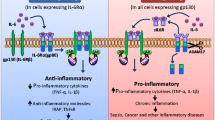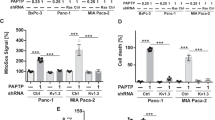Abstract
The production of interleukin-6 (IL-6) has been discovered in a variety of human tumors. Here we report the expression of IL-6, IL-6 receptor α (IL-6Rα), and gp130 in human esophageal carcinoma tissues. We further demonstrate that IL-6 protects an esophageal carcinoma cell line CE48T/VGH from apoptosis induced by staurosporine. IL-6 stimulation induced a rapid phosphorylation of gp130 and STAT3, and a dominant-negative STAT3 completely abolished the antiapoptotic effect. IL-6 also activated ERK 1/2 in CE48T/VGH cells. Inhibition of the ERK activation by PD98059 and transfection of a dominant-negative ERK2 completely blocked the protection of IL-6 against apoptosis. Thus, both STAT and MAP kinase pathways are responsible for the IL-6-delivered survival signal in human esophageal carcinoma cells. In contrast, PI3-K inhibitors only partially attenuated the effect of IL-6, suggesting that PI3-K does not play a major role in the antiapoptotic signal of IL-6 in our system. To investigate whether IL-6 could induce the production of antiapoptotic molecules, proteins of the Bcl-2 family were measured. While Bcl-2, Bcl-xL,, and Bax were not affected, Mcl-1 was induced by IL-6 in human esophageal carcinoma cells. Our results suggest that IL-6 may contribute to the progression of esophageal cancers in an autocrine or paracrine manner.







Similar content being viewed by others
References
Abe K, Hirai M, Mizuno K, Higashi N, Sekimoto T, Miki T, Hirano T and Nakajima K . (2001). Oncogene, 20, 3464–3474.
Blot WJ . (1994). Semin. Onco., 21, 403–410.
Bromberg JF, Wrzeszczynska MH, Devgan G, Zhao Y, Pestell RG, Albancese C and Darnell Jr JE . (1999). Cell, 98, 295–303.
Catlett-Falcone R, Landowski TH, Oshiro MM, Turkson J, Levitzki A, Savino R, Ciliberto A, Moscinski L, Fernandez-Luna JL, Nunez G, Dalton WS and Jove R . (1999). Immunity, 10, 105–115.
Chen RH, Chang MC, Su YH, Tsai YT and Kuo ML . (1998). J. Biol. Chem., 274, 23013–23019.
Chen T, Wang LH and Farrar WL . (2001). Cancer Res., 60, 2132–2135.
Chung J, Uchida E, Grammer TC and Blenis J . (1997). Mol. Cell. Biol., 17, 6508–6516.
Enzinger DC, Ilson DH and Kelsen DP . (1999). Semin. Oncol., 26, 12–20.
Epling-Burnette PK, Liu JH, Catlett-Falcone R, Turkson J, Oshiro M, Kothapalli R, Li Y, Wang JM, Yang-Yen HF, Karras J, Jove R and Loughran Jr TP . (2001). J. Clin. Invest., 107, 351–362.
Fukada T, Hibi M, Yamanaka Y, Takahashi-Tezuka M, Fujitani Y, Yamaghichi T, Nakaajima K and Hirano T . (1996). Immunity, 5, 449–460.
Gallo RL, Dorschner RA, Takashima S, Klagsbrun M, Eriksson E and Bernfield M . (1997). J. Invest. Dermatol., 109, 597–603.
Halapi E . (1998). Med. Oncol., 15, 203–211.
Hirano T . (1998). Int. Rev. Immunol., 16, 249–284.
Hirano T, Ishihara K and Hibi M . (2000). Oncogene, 19, 2548–2556.
Hu C, Hsieh H, Chien K, Wang P, Wang C, Chen C, Lo SJ, Wuu K and Chang C . (1984). J. Natl. Cancer Inst., 72, 577–583.
Kawano M, Hirano T, Matsuda T, Taga T, Horii Y, Iwato K, Asaoku H, Tang B, Tanabe O, Tanaka H, Kuramoto K, Okada N and Kishimoto T . (1988). Nature, 332, 83–85.
Kulik G, Klippel A and Weber MJ . (1997). Mol. Cell. Biol., 17, 1595–1606.
Kulik G and Weber MJ . (1998). Mol. Cell. Biol., 18, 6711–6718.
Kuo ML, Chuang SE, Lin MT and Yang SY . (2001). Oncogene, 20, 677–685.
Lauta VM . (2001). Cytokine, 16, 79–86.
Leu CM, Chang C and Hu C . (2000). Oncogene, 19, 1665–1675.
Lim CP and Cao X . (1999). J. Biol. Chem., 274, 31055–31061.
Ma Y, Xian M, Li J, Kawabata T and Okada S . (1999). APMIS, 107, 514–522.
Mateo RB, Reichner JS and Albina JE . (1994). Am. J. Physiol., 266, R1840–R1844.
Meir EV, Sawamura Y, Diserens A, Hamou M and Tribolet N . (1990). Cancer Res., 50, 6683–6688.
Minshall C, Arkins S, Freund GG and Kelly KW . (1996). J. Immunol., 156, 939–947.
Mocellin S, Wang E and Marincola FM . (2001). J. Immunother., 24, 392–407.
Nakajima K, Yamanaka Y, Nakae K, Kojima H, Ichiba M, Kiuchi N, Kitaoka T, Fukada T, Hibi M and Hirano T . (1996). EMBO J., 15, 3651–3658.
Nobori T, Milura K, Wu DJ, Lois A, Takabayashi K and Carson DA . (1994). Nature, 368, 753–756.
Oka M, Hirose K, Iizuka N, Aoyagi K, Yamamoto K, Abe T, Hazama S and Suzuki T . (1995). J. Interf. Cytok. Res., 15, 1005–1009.
Oka M, Yamamoto K, Takahashi M, Hakozaki M, Abe T, Iizuka N, Hazama S, Hirazawa K, Hayashi H, Tangoku A, Hirose K, Ishihara T and Suzuki T . (1996). Cancer Res., 56, 2776–2780.
Okamoto M, Lee C and Oyasu R . (1997). Cancer Res., 57, 141–146.
Park J, Tadlock L, Gores GJ and Patel T . (1999). Hepatology, 30, 1128–1133.
Puthier D, Bataille R and Amiot M . (1999). Eur. J. Immunol., 29, 3945–3950.
Qiu Y, Robinson D, Pretlow TG and Kung HJ . (1998). Proc. Natl. Acad. Sci. USA, 95, 3644–3649.
Ribeiro Jr U, Posner MC, Safatle-Ribeiro AV and Reynolds JC . (1996). Br. J. Surg., 83, 1174–1185.
Robbins DJ, Zhen E, Owaki H, Vanderbilt CA, Ebert D, Geppert TD and Cobb MH . (1993). J. Biol. Chem., 268, 5097–5106.
Schuringa JJ, Jonk LJC, Dokter WHA, Vellenga E and Kruijer W . (2000). Biochem. J., 347, 89–96.
Singleton JR, Dixit VM and Feldman EL . (1996). J. Biol. Chem., 271, 31791–31794.
Smith PC, Hobisch A, Lin DL, Culig Z and Keller ET . (2001). Cytokine Growth Factor Rev., 12, 33–40.
Taga T . (1997). Annu. Rev. Immunol., 15, 797–819.
Takeda K, Kaisho Y, Yoshida N, Takeda J, Kishimoto T and Akira S . (1998). J. Immunol., 161, 4652–4660.
Wen Z, Zhong Z and Darnell Jr JE . (1995). Cell, 82, 241–250.
Wong F, Hu C, Chiu J, Huang B, Chang J, Lin P, Chien K and Chang C . (1994). Cancer Invest., 12, 121–131.
Yao R and Cooper GM . (1995). Science, 267, 2003–2006.
Zhang Y, Liu G and Dong Z . (2001). J. Biol. Chem., 276, 42534–42542.
Acknowledgements
We thank Dr Jen-Ping Chang, Dr Pyng-Jing Lin, Dr Biing-Shiun Huang, Dr Yi-Ming Chen, and Dr Yi-Jen Chen for providing the surgical specimens. We also thank Dr Ming-Ji Fann and Dr Ruey-Hwa Chen for their valuable suggestions. We appreciate Ms Shiang-Lien Lu for her excellent secretarial assistance. This work was supported in part by Grants NSC88-2314-B075-013 from the National Science Council and VTY89-P5-45 from VTY Joint Research Program, Tsou's Foundation, Taiwan, Republic of China.
Author information
Authors and Affiliations
Corresponding author
Rights and permissions
About this article
Cite this article
Leu, CM., Wong, FH., Chang, C. et al. Interleukin-6 acts as an antiapoptotic factor in human esophageal carcinoma cells through the activation of both STAT3 and mitogen-activated protein kinase pathways. Oncogene 22, 7809–7818 (2003). https://doi.org/10.1038/sj.onc.1207084
Received:
Revised:
Accepted:
Published:
Issue Date:
DOI: https://doi.org/10.1038/sj.onc.1207084
- Springer Nature Limited
Keywords
This article is cited by
-
TRIM29 hypermethylation drives esophageal cancer progression via suppression of ZNF750
Cell Death Discovery (2023)
-
Cytokine profiling identifies circulating IL-6 and IL-15 as prognostic stratifiers in patients with non-small cell lung cancer receiving anti-PD-1/PD-L1 blockade therapy
Cancer Immunology, Immunotherapy (2023)
-
Cross-talk between the microbiome and chronic inflammation in esophageal cancer: potential driver of oncogenesis
Cancer and Metastasis Reviews (2022)
-
Cytokine-chemokine network driven metastasis in esophageal cancer; promising avenue for targeted therapy
Molecular Cancer (2021)
-
STAT3/miR-135b/NF-κB axis confers aggressiveness and unfavorable prognosis in non-small-cell lung cancer
Cell Death & Disease (2021)




